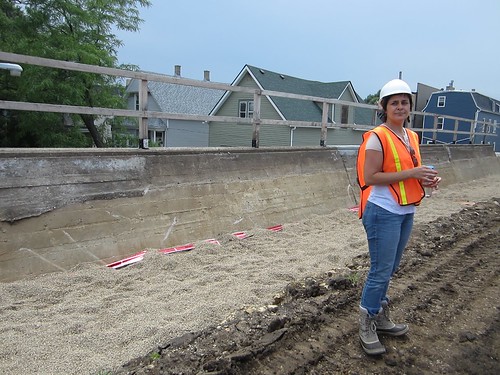Yesterday, Steven and I got a sneak peek at construction on the Bloomingdale Trail on a walking tour led by Jamie Simone from the Trust for Public Land, which is managing the elevated trail and linear park project for the city and the park district.
Last Friday, there was some bad news and some good news about the Bloomingdale, AKA The 606. The Chicago Department of Transportation announced that the opening of the basic trail, previously slated for this fall, has been postponed until June 2015. Construction delays, caused by the unusually long winter, are to blame.
The $95 million project is currently about 45 percent complete, but cold spring temperatures and frozen soil forced crews to postpone the relocation of utilities and structural work, CDOT said. That, in turn, delayed the installation of new concrete in some sections, and forced the department to wait until next spring to do landscape plantings. The upside of this delay is that more of the landscaping will be done by the trail opens than was originally planned.
In a positive development, TPL also announced that it will be buying the Magid (not a typo) Glove factory at 1800 North Ridgeway for about $3 million, and converting it into the trail’s sixth ground-level access park. The new park will be located at the western trailhead, and will provide about four acres of new green space in Logan Square, the second-most park-poor community area in Chicago.
For the tour, we showed up at the field office of TransSystems, the company that is overseeing the trail construction. Joining us was a tour group from Version Festival, an art, planning, and placemaking fest spearheaded by Bridgeport cultural impresario Ed Marszewski. We donned hardhats and safety vests and strolled a couple blocks to a trailhead at Julia de Burgos Park, at Bloomingdale and Whipple.
At access points, crews are lowering the trailbed so that it will slope down towards street level, making it accessible to people in wheelchairs, and everyone else, via gently sloping ramps. Trailheads will be provided every quarter-mile or so, and most locations won't have stairs, Simone said. The linear park will generally be 16 to 18 feet above the ground and thirty feet wide, with the trail itself consisting of a ten-foot-wide concrete path, with two-foot-wide soft rubber shoulders for jogging.
The different heights of the trail will create an undulating effect, which will calm bike traffic and provide an interesting walking and cycling experience, according to Simone. “Chicago is a completely flat city,” she told out-of-towners on the tour. “So we just love any kind of hills. The trail will basically be the biggest hill in Chicago.”
We headed a block east to Humboldt Boulevard, where the line’s longest viaduct is located. Here, there will be bleacher seating on both sides of the trail, so you can gaze down the leafy boulevard. While most of the Bloomingdale will feature “cobra head” lampposts, providing focused illumination, this bridge will be lit by lamps on an arch over the trail.
We’re forced to turn around here, because a worker is removing chunks from the concrete embankment walls using a unique machine called a rope saw. The cutting implement is a cable with pieces of metal on it.
After we head back east, Simone shows us a gravel infiltration bed on the bridge over Albany Avenue. Most of the bridges will feature these beds to help provide drainage.
We soon encountered another construction roadblock and were forced to turn back again, so we concluded the tour with a discussion of how the trail will incorporate art. Marszewski said that, given the politics of installing public art in Chicago, it’s impressive that a single art-related initiative is spanning several wards. “That could only happen on a project that the mayor is pushing hard for,” he said.
School of the Art Institute of Chicago professor Francis Whitehead is serving as the lead artist for the Bloomingdale’s design team. Among her contributions are designing an observatory at the west end of the trail, which will consist of a spiral walkway that will take visitors about ten feet higher for better views of the neighborhood, the natural environment, and the heavens.
Simone said that murals had to be removed from about six miles of the embankment walls for lead paint remediation, which created a blank slate for new artwork. She expect we’ll also see site-specific dance and theater performance along the trail. “Its predominant feature is linearity,” she noted. “People have a million ideas for what they want to do with that.”










